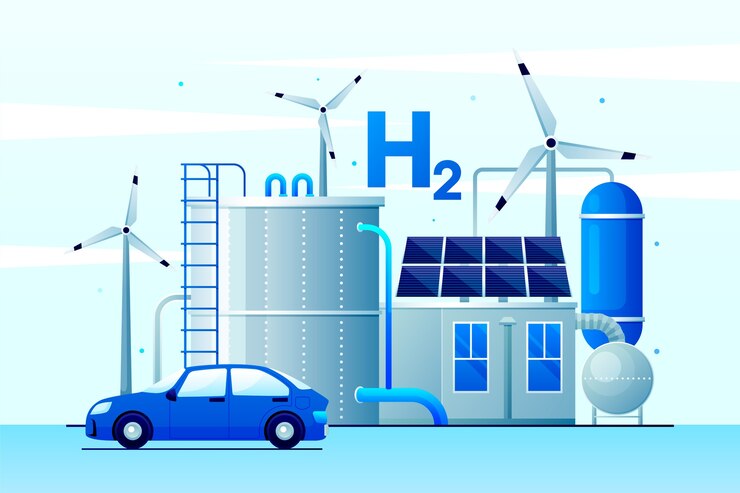Hydrogen Energy: From Fuel Cells to Sector Coupling

In the light of the escalating climate crisis, many countries are in search of alternatives to fossil fuels. The future energy mix must therefore rely on sustainable and carbon-neutral sources. Renewable energy from wind and solar, though abundant, is not consistently available and can lead to excess production at specific times, depending on the time of the day or the season. To address this, reliable and flexible storage options are essential. Hydrogen emerges as a solution due to Power-to-X technology, enabling energy production at any location. Moreover, hydrogen combusts cleanly, making it a promising solution for the logistics sector, particularly where electric mobility reaches limitations. However, expanding hydrogen infrastructure necessitates mature storage and transport solutions.
The Energy Transition Requires Hydrogen
The energy demand of modern industrial societies is high, but reliance on past energy sources is no longer viable. Fossil fuels powering many regions’ electricity grids must make way for emission-free alternatives. Despite ongoing debates on the ideal energy mix in regions already transitioning, one fact still remains: Relying solely on electricity from wind and solar power won’t suffice. To sustainably replace fossil fuel-based electricity, efficient storage solutions are crucial. This is where hydrogen comes in. Previously generated energy can be used to create hydrogen, which can be stored, transported, and converted back into electricity when needed. From a technical perspective, the “combustion” of hydrogen in a fuel cell is based on a chemical reaction with oxygen. When hydrogen comes into contact with this oxidizer, not only water is produced, but also energy is released.
This process emits neither CO₂ nor pollutants that could contribute to environmental problems during electricity generation. As a clean energy carrier, hydrogen could thus help ensure energy supply in various sectors after transitioning to green energy.
Conventional and Green Hydrogen
The diverse usage of hydrogen as an energy carrier represents only one side of the coin. While Power-to-X technology, using excess energy for hydrogen production, plays a key role, current production mainly follows conventional methods. Terms like grey, blue, and turquoise hydrogen are common here. Grey hydrogen, produced from natural gas reforming, is widely used industrially but emits CO₂. Blue hydrogen, increasingly utilized, follows the same production process but captures and stores emissions through Carbon Capture and Storage (CCS), making it more environmentally friendly. Turquoise hydrogen relies on Pyrolysis, generating solid carbon without releasing it into the atmosphere.
However, both blue and turquoise hydrogen are viewed as transitional solutions. The long-term goal is therefore large-scale production of green hydrogen via electrolysis using renewable energy, making it the most sustainable option of them all.
| Hydrogen Color | Production Process | CO₂ Emissions |
| Grey | Steam Methane Reforming | CO₂ Released |
| Blue | Steam Methane Reforming with CCS | CO₂ Captured and Stored |
| Turquoise | Pyrolysis | Solid Carbon |
| Green | Electrolysis with Renewable Energy | No CO₂ Emissions |
Energy Supplier for Heavy-Duty Transportation
Hydrogen is vital not only for direct power generation but also as an alternative fuel for gasoline and diesel. While private vehicles are trending towards full electric power, battery capacities are insufficient for heavy-duty transportation needs. This rekindles interest in fuel cells. Hydrogen vehicles also benefit from rapid refueling; hydrogen tanks take minutes to refill, unlike electric vehicles, which require hours for charging. Several pilot projects are thus exploring fuel cell applications in trucks, vans, and even trains. The adoption of these alternatives in heavy-duty transport depends on the expansion rate of the hydrogen network, benefiting industries involved in gas transport and storage technology – including all necessary measurement devices.
Infobox
To achieve the desired energy density, hydrogen is stored at high pressures, typically between 350 and 700 bar, or extremely low temperatures of -253 °C. Consequently, storage and transport units as well the implemented instrumentation and measurement devices face significant stress.
Sector Coupling: Key to a Decarbonized Economy
Both hydrogen production and its storage impose high demands on technical components. High pressures and low temperatures strain the materials of containers and mechanical parts. Specialized providers have addressed this challenge already. Solutions from companies like WIKA rely therefore on specially designed sensors utilizing suitable materials and when needed additional coatings as hydrogen barriers. Utilizing such technologies is crucial for building a reliable hydrogen network. On these grounds, the extensive goal of infrastructure expansion could be comprehensive sector coupling. This concept involves integrating and connecting various energy system sectors (industry, transportation, heating, etc.) to enhance energy efficiency. Energy generated in one sector should be usable in others as needed. Hydrogen plays a pivotal role in sector coupling, serving as an energy carrier and storage medium. Thus, hydrogen could break the barriers between these sectors, promoting efficient use of renewable energies.